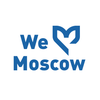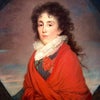Winzavod (Rus.: Винзавод; "wine factory") is a modern exhibition centre in Moscow, Russia, opened in 2007. It is located in a complex of seven industrial buildings from the late 19th century including the former brewery (and later wine factory) called "Moscow Bavaria". Alexander Brodsky is the coordinator of the project.
Captain of the Guards regiment Mel’gunov, the first owner of a large estate situated in modern Mruzovskomu on the corner 4th streets BANKS, sold his estate to his own sister, Princess Catherine Volkonskaya. She was an outstanding Moscow lady and mistress of the Sukhanov Moscow region, and she had the nickname "Aunt Warrior" for her decisive power over her nephew, Peter Volkonsky, the Chief of Staff of Kutuzov. Oddly enough, many decorations of the building survived, and the house itself has not changed in appearance. Destroyed a century ago, the terrace is now restored. The building stands to the right of the entrance to Winzavod, a strong and solid center of the isolated beautiful portico, and in front there is an unusual semi-circular section.
In 1805, Monin bought the manor. After four years in 1810, Nicephorus Prokofiev opened a malt-brewing factory on its territory. In early 1821, the estate passed on to Revel shopkeeper Frederick Danielson of the 2nd Guild, who added a wing to the residential part of the building, along with a two-story brewery and malt house. Long malt warehouses lined the other side of the lane. It is still possible to see the intricately intertwined initials, surrounded by a lush ornamentation of his son Ludwig Fridrikhovich in the tympanum of the portico of the main house. The garden façade focuses on elegant empire-style décor. In the 1840s, the factory, which now belonged to merchants of the first guild William Watson and Peter Dreier, was the second largest in Moscow, after "Trekhgornij". It brewed 57,000 rubles worth of beer each year. In 1855, this huge mansion and factory were owned by the famous "buy-em-up king" Vasily Aleksandrovich Kokorev. He made a fortune on wine sales, was involved in banking, was one of the pioneers of the Russian oil industry, founded several industrial companies and became one of the richest men in Russia.
Kokorev collected paintings and was a patron of the arts: in the gallery, which he established in 1861, he placed more than 500 paintings, including paintings of Briullov, Levitsky, Borovikovsky Kiprensky. P. M. Tretyakov purchased some of them after the owner went bankrupt. For a while there was a factory here of wax, resins and stoppers (plugs/corks), belonging to N. F. Mamontov, which in 1858 was moved to its own premises near the Presnenskaya outpost, where it launched production of varnishes.
In the middle of the 19th century, the western part of the estate was cut off by the Moscow-Kursk railway. The malt building was on the corner of the newly paved lane and unexpectedly increased in urban value. The brewery kept all of its buildings. In the 1870s through the 1880s, brothers Ivan and Cyril Tarusin, the owners of “Moscow Bavaria” (Russian company for beer and mead in Moscow), acquired the factory. The plant was equipped with three steam engines with the total capacity of 45 horsepower, serviced 70 workers, and released a premium beer "Vienna Pure Number 1" for the price of 1 ruble and 60 kopecks per cask. The beverage "Black Velvet" was also famous.
In 1909, part of the estate was acquired by legal representatives of the honorable H. S. Ledentsov, who used his resources for educational purposes; the main house was converted into a four-year college. By this time, the ancient manor had been significantly reduced in size: part of it was cut off by the rail line, and one part, which was given to Yauza, was sold to others. I. P. Goloulin was the head of the houses, and for many years the house was locally named Goloulinskii, and even all the area up to the waterfront Yauza was called Goloulinka.
Across Hludovsky Lane (now BANKS travel, 6), there is a complex of charities associated with the name Gerasim Ivanovich Khludov. Egorievskii peasants, the Khludovs were weaving-artisans; the whole family was set apart in intelligence, enterprise, shrewdness, and hard work. After the death of the founder Ivan Ivanovich, his sons received 200 thousand rubles, which they used to expand production. Soon they were able to start trading in Moscow, and in 1847 they began construction of a cotton mill in Egoryevsk, which became one of the largest cotton mills in the suburbs of Moscow.
Together with his brother Alexei Gerasim, Khludov handled the manufacturing and became one of the richest men in Russia. In 1865, Khludov established an office in Liverpool where he could buy raw materials and steam engines, which lasted for more than forty years. In 1874, they organized the "Partnership on Equal Footing" with a capital of 3 million rubles, and the owners themselves and their families were the only shareholders. The workday at the factory lasted 14 hours for adults and nine hours for children. M. E. Saltykov-Shchedrin dealt with the matter of lawlessness in the factory in the late fifties. But, the blood-sucking Khludovs were also known as benefactors and patrons. Just like Kokorev did, Gerasim Khludov collected paintings by Perov, Aivazovsky, and Briullov; the painting “Fussy Bride” of Fedotov was found in his collection.
After the early death of his only son Paul, KHLUDOV donated several hundred thousand rubles and specifically bought a huge plot of land in Syromyatniki for the construction of a charity-house to care for the poor. After Khludov’s death in 1885, the Merchant Society, with the money that Khludov left them, began construction on a large home-shelter with a church, designed by architect BV Freidenberg. It was opened on May 8, 1888. At that time 50 women and 30 men were placed there, and 150 widows and orphans were placed in 87 free apartments (flats).
Khludov’s daughters were also involved in building the charity Syromyatnikov; Alexandera Naydenova donated funds to build free housing apartments, Lyubov Vostryakova donated funds for free public school, and Praskovya Prokhorova donated to the ward for the weak/afflicted with illness, to a free vocational school for women, and provided yet another building for free apartments (the architect of some of the buildings was the famous Lyev Kekyshev). In Soviet times, Syromyatniki was a large industrial area near the railway station and became a slum.
Businessman Roman Trotsenko founded the Winzavod Center for Contemporary Art. From 2007 to March 2012 the director of the "Winzavod" was the wife of the entrepreneur, Sofia Trotsenko, Dean of the Production Department of Art Theater School. Since March 2012, the Director of Winzavod appointed Elena Panteleyeva, who worked as the chief editor of Winzavod Art Review, a free monthly newspaper published by the art center.





